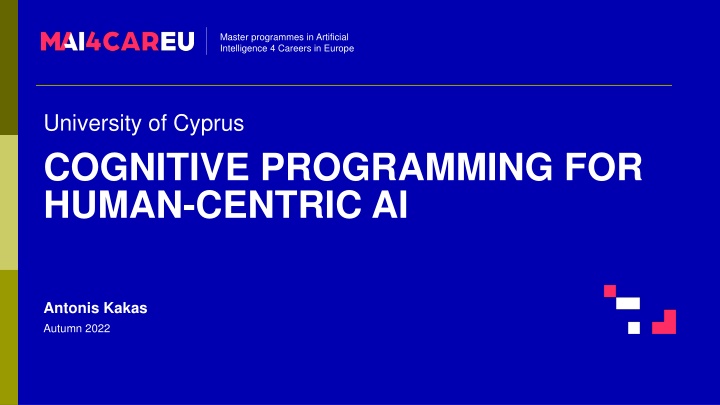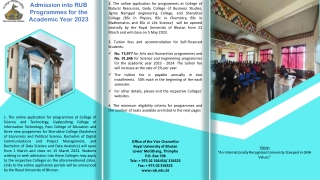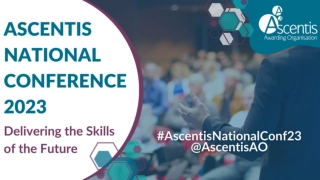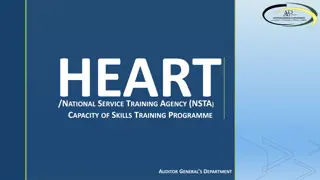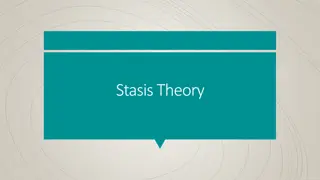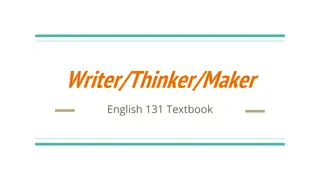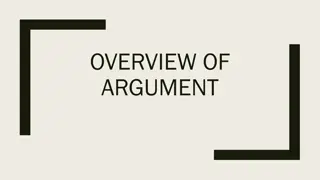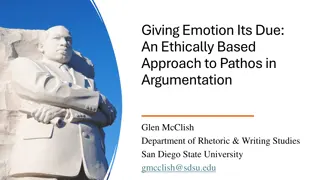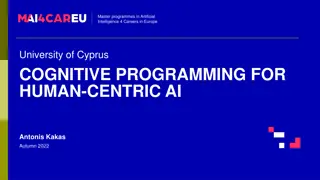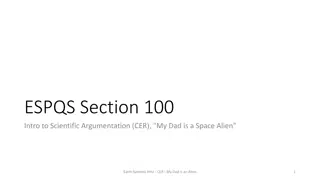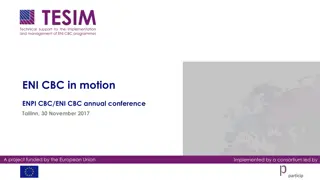Argumentation and Realization in AI Master Programmes
Exploring the concept of argumentation and its realization in artificial intelligence master programmes, focusing on the construction, evaluation, and implementation of arguments through cognitive programming. The framework involves structured argumentation, conflict relations, and strength/preference considerations, emphasizing the importance of constructing arguments with counter-arguments for defense. Argument schemes, premises, positions, and instantiations play a key role in developing human-centric AI systems.
Download Presentation

Please find below an Image/Link to download the presentation.
The content on the website is provided AS IS for your information and personal use only. It may not be sold, licensed, or shared on other websites without obtaining consent from the author.If you encounter any issues during the download, it is possible that the publisher has removed the file from their server.
You are allowed to download the files provided on this website for personal or commercial use, subject to the condition that they are used lawfully. All files are the property of their respective owners.
The content on the website is provided AS IS for your information and personal use only. It may not be sold, licensed, or shared on other websites without obtaining consent from the author.
E N D
Presentation Transcript
Master programmes in Artificial Intelligence 4 Careers in Europe University of Cyprus COGNITIVE PROGRAMMING FOR HUMAN-CENTRIC AI Antonis Kakas Autumn 2022
Master programmes in Artificial Intelligence 4 Careers in Europe Lecture 1 Structured Argumentation 1. Realizations of Computational Argumentation 2
Reminder Argumentation Process <Args, ATT> or <Args, Att, Def> Step 1: Construction of Arguments I.e. Construction of Args Step 2: Evaluation of Arguments Acceptability/Validity of argument sets. 3
Construction of Arguments What is an argument? An argument is a LINK between two pieces of information: premises and position (or claim) of the argument. a1=(bird; fly) A Link, not a Rule! 4
Construction of Arguments Arguments are constructed as instantiations of argument schemes As=(Premises; Position) Argument Schemes are programmed or learned from data analysis or experience 5
Realization of Argumentation <Args, ATT> OR <Args, Att, Def> A realization or a structured argumentation framework of an argumentation framework is: <AS, Cf, St> AS is a set of argument schemes Cf is a conflict relation on the statements St is a strength/preference relation on AS 6
Realization of Argumentation <As, C, > ( = St) As is a set of argument schemes C is a conflict relation (in the language) is a binary strength relation on As
Realization of Argumentation <As, C, > As - construct arguments C - specify counter-arguments - used for arguments to defend themselves
Realization of Argumentation Given <AS, Cf, St> we construct/realize an Arg. Framework: <Args, ATT> or <Args, Att, Def> Args are instantiations of elements of AS a1 attacks a2 , i.e. (a1,a2) Att, if they are in conflict according to Cf. a1 defends against a2 , i.e. (a1,a2) Def if a1 is not weaker than a2 under St. In this case, also (a1,a2) ATT 9
Realization of Argumentation From the philosophical roots of argumentation. Given <AS, Cf, St>then a1 attacks a2 : a1, a2 are in conflict under Cf and named: Rebuttal if conflicting positions of a1 and a2. Undermine if a1 conflicts the premises of a2. Undercut if conflict between the argument schemes of a1 and a2. 10
Example of Realizing Argumentation (See earlier lecture) The power cut had turned the house into darkness. Bob came home and turned on the light switch. Args ={a1,a2,a3} constructed by common sense schemes: a1={turn_on_switch causes light_on, light_on causes darkness} U {turn_on_switch@T} a2={power_cut causes electricity, electricity implies light_on} U {power_cut@T} a3={darkness@T implies darkness@T+} U {darkness@T} Argument schemes here are given names: causes and implies a1 supports darkness@T+; a3 supports darkness@T+
Another Example (from Cognitive Science) Byrne s (1989) Suppression Task 12
Suppression Task (Bryne, 1989) The factual information given along with the conditional(s) in each of the groups can change: She has an essay to finish She does not have an essay to finish She has studied late in the library She did not study late in the library
Byrnes (1989) Suppression Task: She has an essay to finish If she has an essay to finish, then she will study late in the library She has an essay to finish What follows? 1. She will study late in the library 2. She will not study late in the library 3. She may or may not study late in the library 96% Modus Ponens/ Deduction
Byrnes (1989) Suppression Task: She has an essay to finish If she has an essay to finish, then she will study late in the library If she has a textbook to read, then she will study late in the library She has an essay to finish What follows? 1. She will study late in the library 2. She will not study late in the library 3. She may or may not study late in the library 96% Modus Ponens/ Deduction is not affected.
Byrnes (1989) Suppression Task: She has an essay to finish If she has an essay to finish, then she will study late in the library If the library is open, then she will study late in the library She has an essay to finish What follows? 1. She will study late in the library 2. She will not study late in the library 3. She may or may not study late in the library
Byrnes (1989) Suppression Task: She has an essay to finish If she has an essay to finish, then she will study late in the library If the library is open, then she will study late in the library She has an essay to finish What follows? 1. She will study late in the library 2. She will not study late in the library 3. She may or may not study late in the library 38% Humans seem to suppress previously drawn information. They reason non-monotonically!
Byrnes (1989) Suppression Task in Argumentation FORMALIZTION OF THE HUMAN REASONING IN ARGUMENTATION GROUP 1: If she has an essay to finish, then she will study late in the library She has an essay to finish a1: HasEssay StudyLibrary a1 supports StudyLibrary (when given has an essay) a1
Byrnes (1989) Suppression Task in Argumentation FORMALIZTION OF THE HUMAN REASONING IN ARGUMENTATION GROUP 2: If she has an essay to finish, then she will study late in the library If she has a textbook to read, then she will study late in the library She has an essay to finish a1: HasEssay StudyLibrary a2: HasTextBook StudyLibrary h_a3: {} HasTextBook a1 supports StudyLibrary a2 does not support its possible claim a2 = {a2,h_a3} supports StudyLibrary a1 a2 But no attacks (no conflicts)!
Byrnes (1989) Suppression Task in Argumentation FORMALIZTION OF THE HUMAN REASONING IN ARGUMENTATION GROUP 3: If she has an essay to finish, then she will study late in the library If the library is open, then she will study late in the library She has an essay to finish a1: HasEssay StudyLibrary a2: OpenLibrary StudyLibrary a3: not OpenLibrary not StudyLibrary h_a4: {} not OpenLibrary a5= {h_a4, a3} acceptable argument supportsnot StudyLibrary a5 attacks a1 but not vice versa! h_a6:{} OpenLibrary {a1, h_a6} acceptable argument for StudyLibrary a6 a1 a5
NL Comprehension Text (Story) Comprehension http://cognition-srv1.ouc.ac.cy/~adamos.koumis/star.html http://cognition-srv1.ouc.ac.cy/~adamos.koumis/index.html 21
PART 3 COMPUTATIONAL ARGUMENTATION in PRACTICE 22
Applications as Argumentation based Decision Making Decision of O (or Derive Conclusion ): Argument for O (or ) No argument for another O (or ) Through Good Quality arguments, i.e.: Acceptable arguments 23
Practical Application of Argumentation Populate a Realization <AS, C, St> Argument/Knowledge engineering/acquisition Consider computational heuristics in the dialectic argumentation process Cognitively based (sometimes) 24
Populate <AS, C, St> The challenge is to capture: Contextual Strength/Preference relation St St is not global Context dependent Hence we need to decide on the strength while deciding on the Option to choose! Two intertwined decisions Arguing about Options reduces to arguing about the strength of arguments supporting the Options 25
Decision Making in Argumentation Knowledge (SBPs) for Decision Making General, Cognitive Form of Knowledge: Generally, in SITUATIONpreferOis, but when in particularCONTEXT, prefer Ojs. Generally, deny calls when {busy at work} but allow calls from {collaborators}. Scenario-based Preferences: <Id, Scenario_Conditions, Preferred_Options>
Representation Language/Process (Study Assistant Example) Separate Options and Scenario Language Options: Study at Library, Home, Caf Capture Hierarchies of Scenario-based Preferences amongst the Options <1, {Homework}, {Home, Cafe}> <2, {Homework, Late}, {Home}> <3, {Homework, Need_Sources}, {Library}> Capture anti-preferences ( or contra- indications) for an individual Option. <a1, {Closed_Library}, {-Library}> 27
Refinement & Combinations of Scenarios-based Prefs Refinement of Scenarios with extra condition(s). Example 1: <1, {Homework}, {Home, Cafe}> <2, {Homework, Late}, {Home}> Preferred options (e.g. Home) in more specific scenario win. Therefore arguments in more specific scenario are stronger: Home preferred over Caf (and over Library)
Refinement & Combinations of Scenarios-based Prefs Combination of Scenarios with conflicting options Example 2: <2, {Homework, Late}, {Home}> <3, {Homework, Need_Sources}, {Library}> <2|3, {Homework, Late, Need_Sources}, ???> In combined scenarios the Preferred Options are specified independently (or via common sense), e.g.: {Library} But {Home, Library} is also possible, i.e. no preference/do not know/have not learned this yet!
Exercise Consider your own Personal Study Assistant Assistant needs to figure out where we will be studying/working today! Express your preferences amongst the three options of Library, Caf , Home in the form of Scenario-based Preferences. 30
Master programmes in Artificial Intelligence 4 Careers in Europe This Master is run under the context of Action No 2020-EU-IA-0087, co-financed by the EU CEF Telecom under GA nr. INEA/CEF/ICT/A2020/2267423
